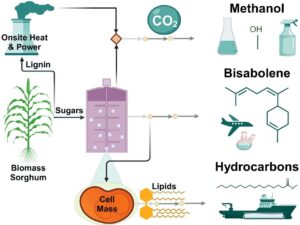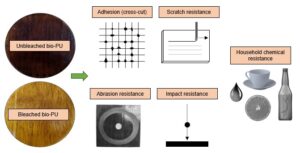Research Articles
Latest articles
- Researchpp 4056-4086
Baral, N. R., Banerjee, D., Mukhopadhyay, A., Simmons, B. A., Singer, S. W., and Scown, C. D. (2024). “Integration of genome-scale metabolic model with biorefinery process model reveals market-competitive carbon-negative sustainable aviation fuel utilizing microbial cell mass lipids and biogenic CO2,” BioResources 19(3), 4056-4086.AbstractArticlePDF Award Winner: 2023 BioResources Early Career Investigator Award
Award Winner: 2023 BioResources Early Career Investigator Award
Producing scalable, economically viable, low-carbon biofuels or biochemicals hinges on more efficient bioconversion processes. While microbial conversion can offer robust solutions, the native microbial growth process often redirects a large fraction of carbon to CO2 and cell mass. By integrating genome-scale metabolic models with techno-economic and life cycle assessment models, this study analyzes the effects of converting cell mass lipids to hydrocarbon fuels, and CO2 to methanol on the facility’s costs and life-cycle carbon footprint. Results show that upgrading microbial lipids or both microbial lipids and CO2 using renewable hydrogen produces carbon-negative bisabolene. Additionally, on-site electrolytic hydrogen production offers a supply of pure oxygen to use in place of air for bioconversion and fuel combustion in the boiler. To reach cost parity with conventional jet fuel, renewable hydrogen needs to be produced at less than $2.2 to $3.1/kg, with a bisabolene yield of 80% of the theoretical yield, along with cell mass and CO2 yields of 22 wt% and 54 wt%, respectively. The economic combination of cell mass, CO2, and bisabolene yields demonstrated in this study provides practical insights for prioritizing research, selecting suitable hosts, and determining necessary engineered production levels.
- Researchpp 4087-4103Ji, H., Yang, Y., Zhang, H., Li, B., and Cheng, L. (2024). “Decay level classification of wooden components in Tingbao Yang’s former residence utilizing polarization and fluorescence effects,” BioResources 19(3), 4087-4103.AbstractArticlePDF
Decay levels of wooden components in the Yang former residence were classified using polarized light and fluorescence methods. Analysis of the decay cause was conducted based on external conditions and wood species characteristics. The polarization and fluorescence effects revealed that there were varying degrees of decay in larch (Larix potaninii var. australis), spruce (Picea brachytyla), lace-bark pine (Pinus bungeana), Masson pine (Pinus massoniana), Chinese Douglas fir (Pseudotsuga sinensis), Chinese fir (Cunninghamia lanceolata), poplar (Populus tomentosa), and elm (Ulmus pumila). The primary factors contributing to decay included the inherent low natural durability of the wood species and adverse external conditions, such as damaged roofs, missing dripping water and tiles causing water leakage, uneven indoor and outdoor ground levels, contemporary tile paving indoors, and inadequate ventilation. This study aims to establish a scientific basis for subsequent conservation strategies.
- Researchpp 4104-4119Radmanović, K., Balaško, K., Pervan, D., Lončar, F., Dujmović, M., and Šafran, B. (2024). “Determining thermal properties of beech and fir wood samples in longitudinal direction via modified transient plane source method,” BioResources 19(3), 4104-4119.AbstractArticlePDF
The increasing use of wood leads to the need for a better understanding of its thermal properties with the aim of quantitatively identifying the exchange of thermal energy between wood and the surrounding solar radiation as precisely as possible. Reliable and rapid measurement of thermal conductivity is one of the most important current industrial requirements. The aim of this study is to examine the validity of using the modified transient plane source method (MTPS), which uses the principle of one-sided heating of the sample, and is defined by the ASTM D7984-21 (2021) standard, for determining the thermal conductivity of complex biocomposite composite materials such as wood. The analysis of the available literature shows a lack of data on the thermal conductivity of the type of wood originating in Croatia. In this study, the thermal conductivities of beech and fir wood samples in the longitudinal direction was determined by the MTPS method depending on the temperature and moisture content in the samples. Measurements were made on samples with a moisture content of 0%, 10%, and 20% in the temperature range from 20 to 80 °C.
- Researchpp 4120-4134Singer, H. (2024). “Location selection for a lumber drying facility via a hybrid Pythagorean fuzzy decision-making approach,” BioResources 19(3), 4120-4134.AbstractArticlePDF
The strategic selection of facility locations plays a critical role in optimizing operational efficiency, reducing costs, and enhancing customer satisfaction, thereby contributing significantly to the success and competitiveness of businesses. In this study, an interval-valued Pythagorean fuzzy decision-making framework is proposed to select the best location for the lumber drying industry. A four-level hierarchical model is devised with four main criteria, 16 subcriteria, and five alternatives. The opinions of different experts are gathered to obtain input data. The weights of the criteria are calculated using the interval-valued Pythagorean fuzzy analytic hierarchy process (AHP) method. The interval-valued Pythagorean fuzzy weighted aggregated sum product assessment (WASPAS) method is employed to evaluate the alternative locations. A sensitivity analysis is conducted to support the validity of the model results. The study concludes by revealing the optimal location for the lumber drying industry in Turkey. This study presents its novelty by formulating the lumber drying facility location selection problem as a complex fuzzy multicriteria decision-making problem and integrating the Pythagorean fuzzy AHP and WASPAS methods to solve the problem.
- Researchpp 4135-4154Kurul, F., and As, N. (2024). “Visual and machine strength gradings of Scots and red pine structural timber pieces from Türkiye,” BioResources 19(3), 4135-4154.AbstractArticlePDF
Scots (Pinus sylvestris L.) and red pine (Pinus brutia Ten.) structural timbers (540 pieces) from Türkiye were first visually graded according to TS 1265 (2012). Then, non-destructive tests were conducted using vibration and time of flight (ToF) methods, followed by destructive tests on a four-point bending test setup according to EN 408 (2012). The vibration method showed a higher correlation than ToF with strength and stiffness. The dynamic modulus of elasticity (MOEd) obtained by the vibration method was 12.3% and 15.4% lower in Scots and red pine, respectively, compared to the ToF method. Mechanical testing determined local MOE was 14% and 15% higher than global MOE for Scots and red pine, respectively. An alternative formula to the existing conversion formula in EN 384 (2018) was derived. The average bending strength of red pine was 7% higher than Scots pine. For visual strength grading, local and global MOE in Scots pine, class 1, 2, and 3 structural timbers were assigned to C35, C27, and C22, respectively. Red pine was assigned to C40, C27, and C24 for local MOE and C35, C24, and C22 for global MOE. In machine strength grading, the grade combination was C40-C30-C22-C16-R for both species. The best results were achieved in settings where vibration method and local MOE were used together. Machine strength grading achieved higher efficiency than visual strength grading.
- Researchpp 4155-4164James, R. M. S., Tahir, P. M., Mohd Yusof, N., Osman al-Edrus, S. S., Abidin, Z. Z., Uyup, M. K. A., Antov, P., Fatriasari, W., and Lee. S. H. (2024). “Finishing properties of bleached and unbleached bio-polyurethane wood coating,” BioResources 19(3), 4155-4164.AbstractArticlePDF

To obtain a more appealing wood coating with lighter color, bleaching treatment was employed. Bleached and unbleached bio-polyurethane (PU) coating was prepared using liquefied bamboo and was applied to rubberwood. The coated wood surface was examined for adhesion, scratch, abrasion, impact, and resistance to common household chemicals. The results revealed that the bleaching of liquefied bamboo exerted mixed effects on the finishing properties of the bio-PU coating. Specifically, the surface coated with unbleached bio-PU coating exhibited noticeably higher levels of scratch and impact resistance compared to the surface coated with bleached bio-PU coating. However, both the adhesion and abrasion properties were found to be similar in both cases. Both bleached and unbleached bio-PU coating exhibited similar resistance to various household chemicals, with exception of acetic acid. This research demonstrated a method for producing semi-transparent bio-PU from bamboo biomass for use in wood coating. Bleaching treatment is feasible to produce light-colored coating without significantly affecting the finishing properties of the bio-PU coating.
- Researchpp 4165-4180Yasar, S. S., Yalinkilic, A. C., and Yasar, M. (2024). “Color properties of tannin-treated wood,” BioResources 19(3), 4165-4180.AbstractArticlePDF
The color-changing effect of tannin, which is a sustainable and environmentally friendly material used in wood preservation, was studied on varnished and un-varnished wood samples. For this purpose, walnut tannin was applied on samples prepared from Scots pine (Pinus sylvestris L.) and walnut (Juglans regia L.) wood in accordance with ISO 3129 (2019) standard with a brush, and then samples were coated with polyurethane varnish and water-based varnish according to ASTM D3023-98 (2017) principles. Color changes were determined according to ASTM D2244-21 (2021). The obtained data indicated that the highest value in the red color tone (a*) was observed in Scots pine+tannin+polyurethane varnish (PU) (14.4) and the lowest was in Scots pine+control+unvarnished (Uvr) (6.5). The highest value for the yellow color tone (b*) was observed in Scots pine+tannin+PU (34.1), the lowest was in walnut+control+Uvr (14.4), and the highest color lightness value (L*) was obtained in Scots pine+control+Uvr (77.0), and the lowest was obtained in walnut+tannin+PU (18.9). The tannin application, which darkened the wood surface, increased the a* and b* values in both wood types while decreasing the color lightness values 60% to 70%. Tannin application caused a noticeable decrease in total color changes in Scots pine.
- Researchpp 4181-4198Song, N., Shin, S., Kim, K., Choi, S., Kim, Y., Kim, E., Kim, S., and Park, K. (2024). “Antioxidant, anti-photoaging, anti-inflammatory, and skin-barrier-protective effects of Gleichenia japonica extract,” BioResources 19(3), 4181-4198.AbstractArticlePDF
Ferns native to Korea, such as Davallia mariesii, Dicranopteris pedata, and Gleichenia japonica, possess antioxidant and antibacterial properties. However, their inhibitory effects on skin photoaging have not been demonstrated. Measurement and comparison of the antioxidant activity of three types of ferns revealed that the extract from G. japonica had the best effect. This study evaluates the potential of G. japonica extract as a new functional material for preventing skin damage caused by ultraviolet radiation. G. japonica extracts showed protective effects against ultraviolet B (UVB) radiation in human epidermal keratinocyte cells; the extracts inhibited intracellular reactive oxygen species production. In addition, collagen biosynthesis increased, and matrix metalloproteinase-1 activity and protein expression level decreased in human primary dermal fibroblast irradiated with UVB. The main peak (compound 1) of the extract was separated through high-performance liquid chromatography analysis and preparative liquid chromatography. Compound 1 is strongly inferred to be the main active ingredient because it showed better antioxidant activity and UVB protection effect than G. japonica extract. These results demonstrate the physiological effects of G. japonica extract and suggest its applicability as a new functional substance for preventing skin damage caused by ultraviolet radiation.
- Researchpp 4199-4212Bayraktar, D. K., and Güneş, M. (2024). “Optimization of hardness values via Taguchi method for chestnut wood etched or impregnated with sodium bicarbonate after artificial aging,” BioResources 19(3), 4199-4212.AbstractArticlePDF
In today’s wood industry, research is being conducted to increase material strength, ensure long-term use, and increase its hardness against many harmful external factors. With the studies on the protection of wood, new protection materials and methods are introduced. In this study, wood was etched with solid sodium bicarbonate (NaHCO3) and 1, 2, and 3 bars of air pressure after treatment with NaHCO3 solution and drying. The change in hardness values of impregnated and surface-treated (paint, varnish) chestnut wood after artificial aging was examined. Etching, impregnation, and surface treatment factors were optimized using the Taguchi design of experiments (DoE) after artificial aging for 3, 6, and 9 months. L16 orthogonal array was used to determine the optimum conditions for determining hardness values and their percentage changes. The results showed that the abrasive factor prevails over the effect of surface treatments. It has been understood that the most effective factor in the hardness value changes during the artificial aging period (3-6-9 months) is abrasion, and the factor with the least effect is the surface parameter. The percentage accuracy of the model used in estimating the wear factor average R2 across all dependent variables was 95%.
- Researchpp 4213-4237Wani, A. W., Hassan, G. I., Bhat, K. M., Ahmad, M., Siddiqui, M. H., Kumar, S., Naresh, R. K., and Gupta, R. K. (2024). “Utilizing SSR markers to examine the population structure and molecular genetic diversity of walnut (Juglans regia L.) genotypes in the Northwestern Himalayan region of Jammu and Kashmir,” BioResources 19(3), 4213-4237.AbstractArticlePDF
By using 16 simple sequence repeat (SSR) markers, the genetic relatedness of 21 exceptional walnut genotypes was assessed. A significant degree of genetic diversity was observed within a given population, as indicated by the number of alleles per locus ranging from 2 to 4. WGA-1, WGA-4, and WGA-79 contained the greatest number of alleles (4), followed by WGA-118, WGA-202, and WGA-42. Conversely, WGA-27, WGA-69, and WGA-32 contained the fewest alleles. The range of the PIC value was 0.11 to 0.38. Using model-based cluster analysis, all genotypes were categorized into two primary clusters according to the UPGMA dendrogram, with varying degrees of sub-clustering. All the genotypes were categorized into six genetically distant subpopulations. The genotypes were genetically distinct but had variable degrees of admixture. The anticipated heterozygosity at a specific locus ranged from 0.563 to 0.741. Additionally, population differentiation (Fst) ranged between 0.176 and 0.261. These findings highlight the importance of considering germplasm diversity in walnut breeding programs and conservation efforts aimed at enhancing walnut cultivation in the region. Overall, this study contributes to our understanding of walnut genetic diversity in the Northwestern Himalayan region of Jammu and Kashmir and informs future breeding and conservation strategies.
